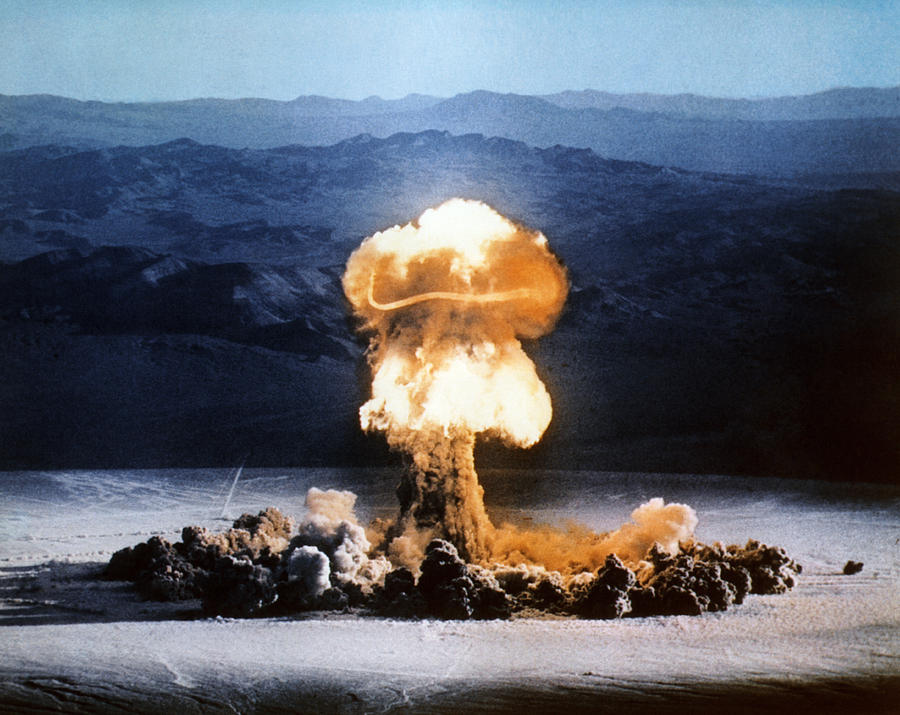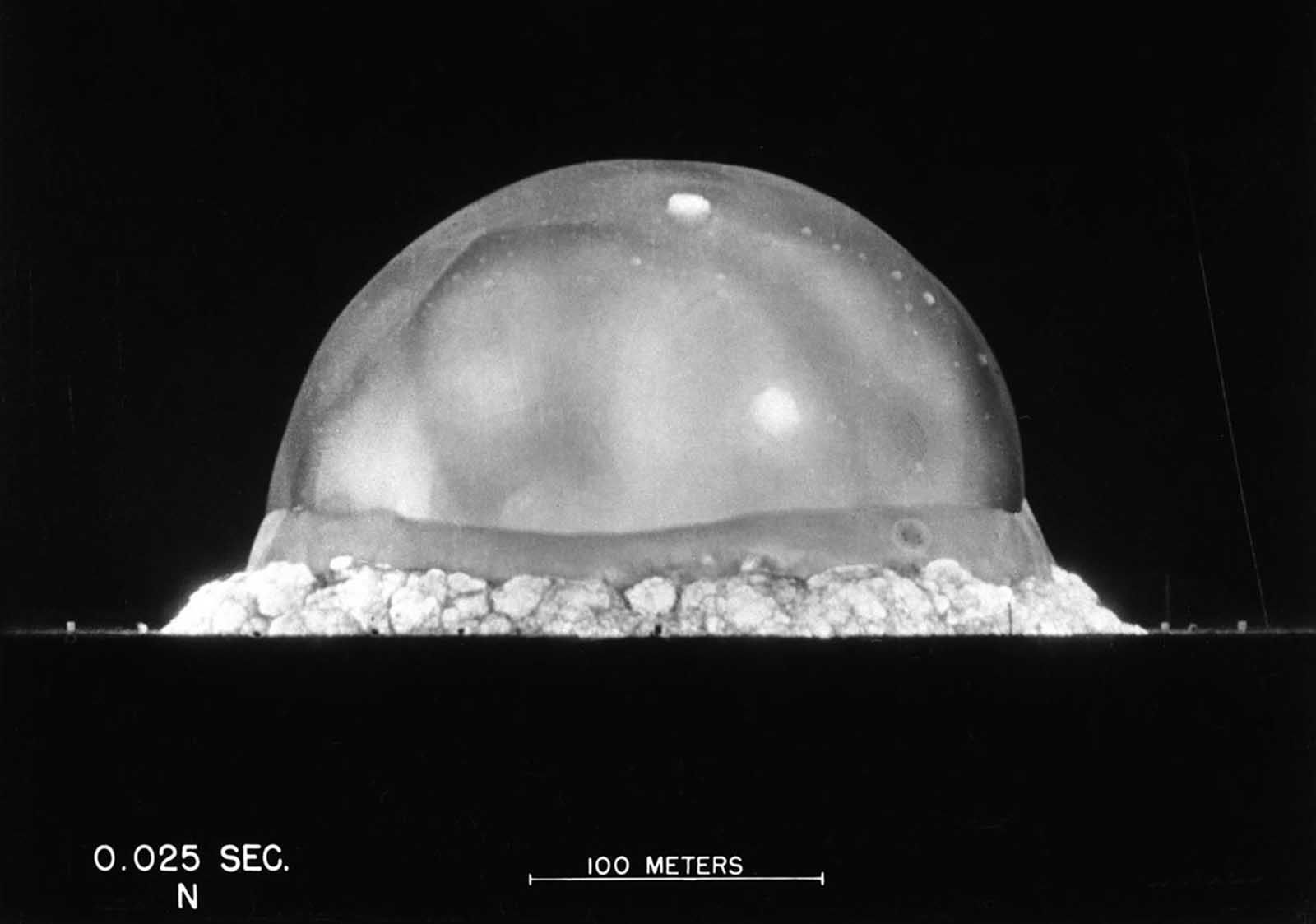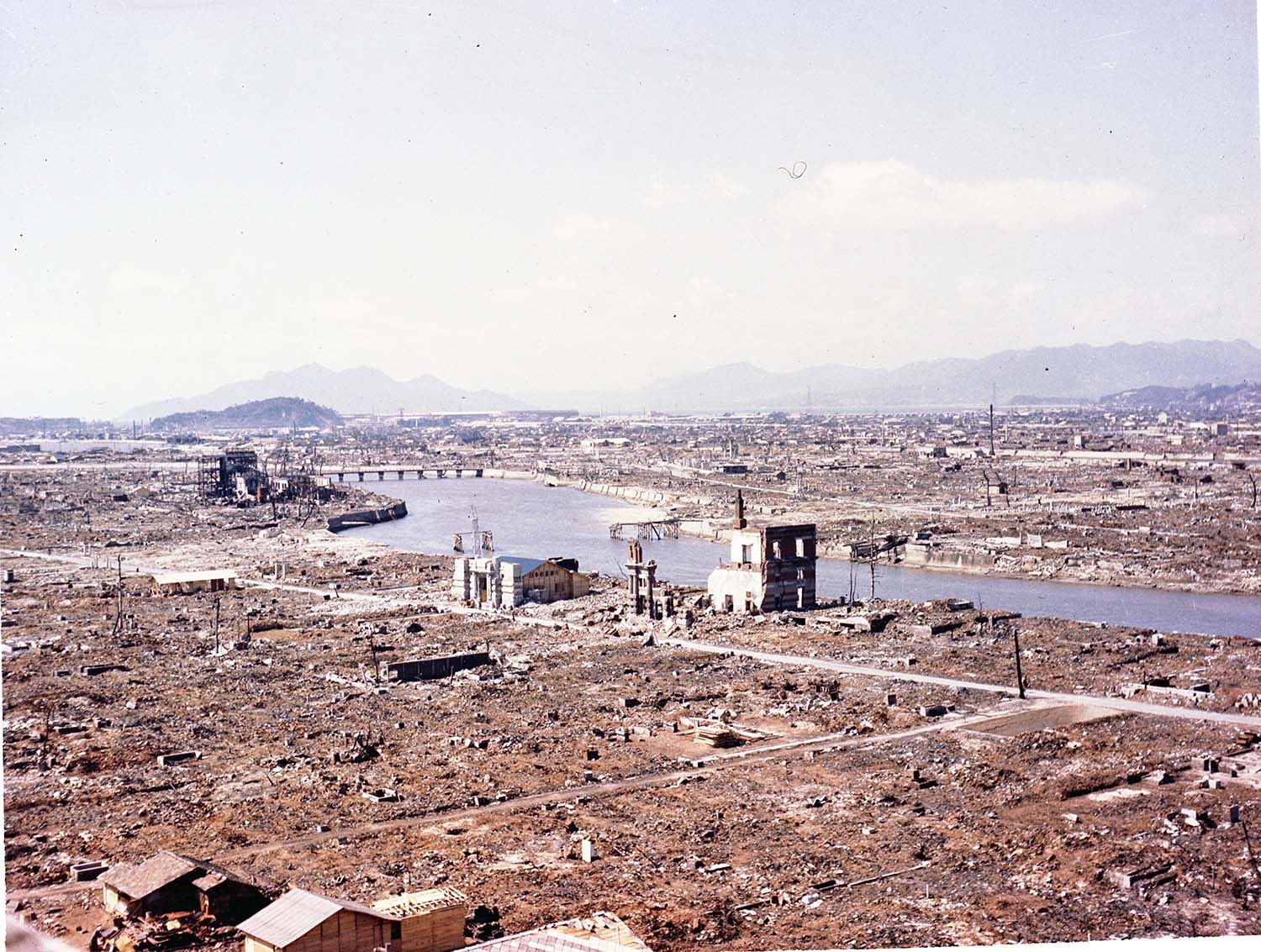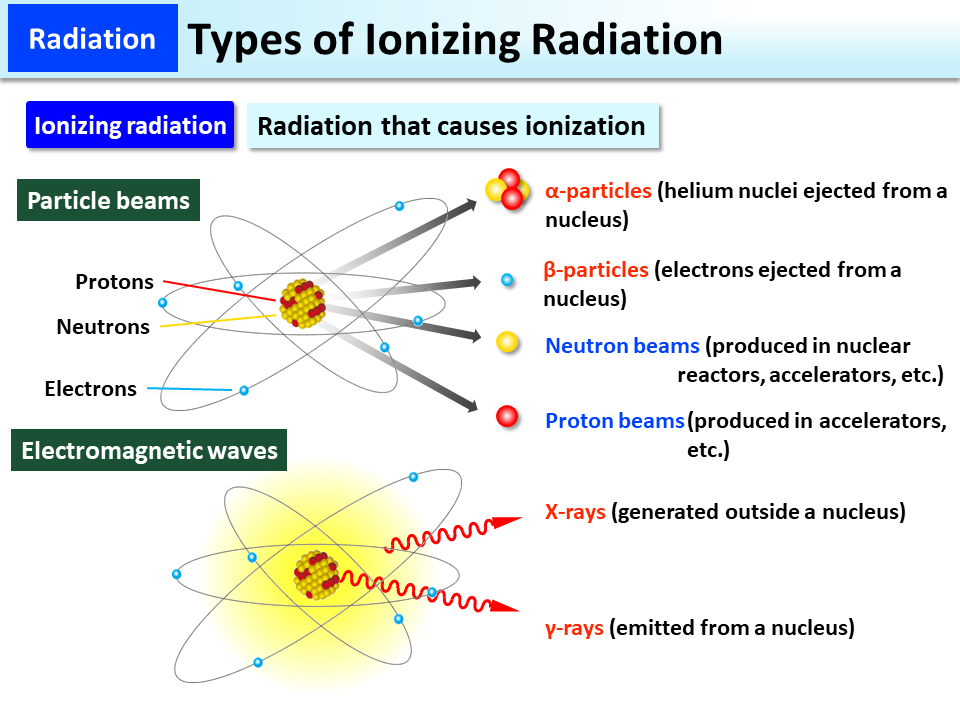Risks → War → Nuclear War → Nuclear Explosions
Nuclear explosions are massive, deadly and create a hell of a mess.

Priscilla nuclear test, Nevada, June 24, 1957, yield 37 kilotons, exploded from a balloon
Source: Wikimedia Commons. See: https://commons.wikimedia.org/wiki/File:Operation_Plumbbob_-_Priscilla.jpg
Yield
The explosive energy produced by a nuclear detonation (yield) is vastly in excess of standard conventional bombs. Their explosive yield is expressed in terms of tons of TNT, so a 1 kiloton nuclear weapon would generate the same level of explosive energy as detonating 1,000 tons of TNT. Similarly, a 1 megaton nuclear bomb would produce equivalent energy to detonating 1,000,000 tons of TNT.
Destructive elements/effects of a nuclear bomb
There are several destructive elements/effects, immediate and delayed, that all nuclear explosions share. The actual extent, that each element will impact on infrastructure, terrain or people, however, will vary relative to the size and composition of the weapon detonated, whether it is exploded in the atmosphere (air burst), at ground level (surface or ground burst) or sub-surface (sub-surface burst), what time of the day it is dropped, the weather at that time and the actual nature of the terrain targetted.
These immediate and delayed elements/effects are summarised below:
Immediate Effects:
- Thermal Radiation (Fireball/Heat)
- Blast
- Prompt Ionising Radiation/Nuclear Radiation
Delayed Effects:
- Radioactive Contamination/Fallout
The immediate effects, viz., thermal radiation, blast and ionising radiation, are detailed below. Delayed radioactive fallout is detailed on a separate page.
Thermal Radiation
For a 1 megaton detonation around 45% of the energy produced from a nuclear explosion comes in the form of thermal radiation, i.e., light and heat. In lower yield detonations (less than 100 kilotons) this proportion reduces to 35 percent.
Immediately after detonation of any nuclear weapon a large fireball is produced with temperatures of up to
100 million degrees C, approximately the same temperature as the interior of our Sun. Within one millisecond from detonation,
the fireball from a 1 megaton weapon will measure around 150 meters across,
increasing to a maximum diameter of around 2 km in 10 seconds. As the fireball increases in size, and then cools, the vapours condense
to form the mushroom shaped cloud which is atypical of a nuclear blast. The cloud contains both solid particles (weapon debris),
and droplets of water derived from the air sucked up into the rising fireball. Depending on the height of explosion, a strong updraft with inflowing winds,
called "afterwinds," will develop sucking up additional dirt and debris. An airburst will suck up only a small amount,
while in a ground burst, a large amounts of dirt and debris will be drawn up. The mushroom cloud attains its maximum height after about
10 minutes and is then said to be "stabilized." It will then disperse.
Thermal radiation induces damage by rapid heating, inducing fire in flammable materials, the area of thermal damage
increasing approximately linearly to explosive yield. A 1 megaton explosion, for example, will effect an area 10 times lager than a
bomb with a 100 kiloton yield.
Most fires initiated by thermal radiation are extinguished by the shock wave, but additional fires can occur if debris produced by the shock wave is reignited (for example by remnant smouldering materials or fires caused by pilot lights, leaking gas mains or blast created infrastructure damage). Collapsed buildings and infrastucture are more vunerable to fire than intact structures. If enough burning debris is present, a firestorm can result. After the Hiroshima bombing a firestorm covering more then 4 square miles occurred, while there was no firestorm in the Nagasaki explosion. The nature of the terrain and weather will dictate whether a firestorm develops or not.
Effect on humans - Thermal energy travels at the speed of light so the first effect on humans is a flash of blinding light and heat. If you look directly at the explosion one is exposed to flash blindless a temporary loss of vision that can last many minutes. After detonation of a 1 megaton weapon, people up to 20km away would experience flash blindness. On a clear night people up to 85 km away would experience it. The effect from heat is more intense the closer one is to the explosion. Again for a 1 megaton weapon, at 8 km 3rd degree flash burns (burns that completely destroy tissue) will be common, at 10 km 2nd degree flash burns and at 11 km 1st degree burns might result. These distances, however, are variable and will depend not just on local weather conditions and terrain but also on the clothes you might be wearing. White clothes can reflect thermal energy while black clothes will absorb it. Note, 3rd degree burns over 24 percent of ones body, or 2nd degree burns over 30 percent and can result in death unless promptly treated. It has been estimated that burns caused some 50 percent of the deaths at Hiroshima and Nagasaki.

Fireball produced by the Trinity test, the world's first nuclear bomb, 1945, 0.025 seconds after detonation.
Source: https://rarehistoricalphotos.com/trinity-test-day-nuclear-age-began-1945/
Blast
Blast is the most destructive element in any nuclear detonation, causes the most damage and accounts for 50 to 60 percent of the total energy released.
Blast is a result of the formation of the nuclear fireball, which induces an outward, rapidly moving, high pressure shock wave. Shock waves cause an instantaneous jump in pressure at the shock wave front, termed overpressure. The air behind the shock wave is also accelerated to high velocities creating an accompanying powerful wind.
The fireball shock wave moves very rapidly. For a 1 megaton explosion, the fireball will reach its maximum diameter of around 2 km in 10 seconds, then will no longer be visible. At this point the shock front is some 5 km ahead. At 50 seconds the shock front will have expanded to nearly 20 km from ground zero. The destructive power of any nuclear blast is therefore immense. Overpressure principally affects large buildings causing collapse. The most damage, however, is produced by the accompanying high speed wind that can far out strip those from a major hurricane (+800 mph).
The following table provides a summary of the levels of blast damage produced by a nuclear explosion:
| Overpressure | Accompanying Physical Effects | Accompanying Wind Speed |
|---|---|---|
| 40 psi | Total devistation | 800 mph |
| 20 psi | Massive destruction All people killed | 500 mph |
| 10 psi | Concrete buildings severely damaged or demolished Most people killed | 300 mph |
| 5 psi | Most building collapse Many killed | 150 mph |
| 3 psi | Some building collapse Serious injuries common, some fatalities | 70 mph |
| 1 psi | Window glass shatters Light injuries common | - |
Effect on humans - Humans are resistant to overpressure at levels up to 40 psi. Overpressures over 40 psi, however, will be lethal. The main danger to humans comes from the collapse of buildings due to overpressure. Similarly high wind speeds will cause severe damage to buildings/infrastructure/vegetation and create large quantities of flying and air born debris, again leading to many fatalities. If fire is associated with collapse, danger to life will be even greater. In general terms, if you live in a city you would have little chance of survival at overpressures of 5 psi or over. 3 psi is the survival contour for overpressue.

Destruction at Hiroshima, 1945
Source: USA National Archives. See: https://www.archives.gov/news/topics/hiroshima-nagasaki-75
The Mach Stem - If the nuclear explosion occurs above ground level, when the initial blast wave hits the ground, it is reflected to
form a second shock wave travelling behind the first. These waves (incident and reflected) then merge to form a single wave known as the
Mach Stem. The overpressure produced by the Mach Stem is roughly twice as great as the direct blast wave, An air burst explosion is therefore more
destructive than a ground burst explosion.
Prompt Ionising Radiation/Nuclear Radiation
Prompt or initial ionising radiation accounts for about 5 percent of the explosive yield of any nuclear detonation.
Ionising radiation comprises both atomic particle emissions/beams (alpha and beta particles and neutrons) and eletromagnetic waves
i.e., x-rays and y-waves (gamma waves) with neutron beams and gamma waves dominating in a nuclear detonation. At detonation
the level of ionising radiation can be very intense, but as it occurs only while nuclear fission is ongoing in the fireball, its duration is very short.
it is also strongly absorbed by the air it travels through, which in turn causes intensity and dispersion
to drop off rapidly away from ground zero.
In large bombs, its range is less than both the thermal and
blast waves. However, in especially designed smaller weapons (such as neutron bombs) its range can be much greater.
Effect on humans - Direct exposure to prompt ionising radiation from a nuclear detonation, because of its intensity, will be lethal. However,
because of its limited duration and range, the number of casualties will generally be few. The thermal pulse or shock wave will kill first.
The greatest danger to humans from radiation comes from delayed radiation
associated with nuclear fallout.

Types of ionising radiation (note: y-rays = gamma rays)
Source: Ministry of the Environment, Japan. See: https://www.env.go.jp/en/chemi/rhm/basic-info/1st/01-03-03.html